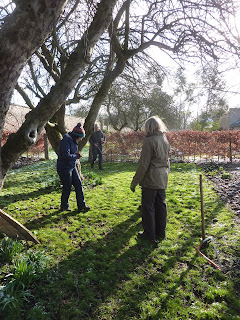 |
| 2018's raspberry supports next to 1995's (left) |
Today was a glorious - if brisk start; more snow had fallen at the weekend - the remnants of which still showed themselves in light patches across the garden. My first day in the gardens involved installing huge wooden poles as supports for the new raspberry plants; indeed, Giles later said that one of his first tasks as Head Gardener had been to install raspberry supports in 1995. These poles still stood solid - 23 years later. I looked forward to making my contribution. Today we were to finish the job we started in February using metal wire. The tools - a huge metal hammer, a drill with a huge drill bit and fencing pliers.

Meanwhile, Beth and I headed to the vegetable garden; an order had been placed by Sir James. There are thin pickings at this time of year, but there was still some wonderful fresh Kale, Leeks and Celeriac. We took them to the Orangery, where they were washed in a bucket of water and trimmed.
Some earlier crops remained in the apple store - we filled up the vegetable box further with potatoes, beetroot and apples.
 |
| The view from the top of the Apple Store ladder |
 |
| A vegetable box for Sir James and Lady Halina |
Shandy and Plum accompanied us to our next task of the day. We would cut back the huge, established apple trees. Giles explained that they were towards the end of their lifespan, but would probably last at least another 20 years. Water shoots - or sprouts - were out biggest enemy today; they form when an Apple tree is cut back. In order to discourage this, the shoots had to be cut right back to their base. And there were hundreds of them. We made a start, but it wasn't long before lunchtime.
In the Orangery; a 'Celebrations' box lay on the table. As I sat down, Bex passed the box over to me, along with an envelope. I was intrigued, but couldn't work out what this was about. A birthday cake - baked by the lovely - and multi-talented Bex. Raspberry and honey - it was beautiful, moist and really delicious. And a birthday card too, adorned with a smiling sheep - in reference to last week's adventures. This was signed by all the gardeners too - even Plum and Shandy!!
Given the fact that these apple trees are older trees, it is even more important to cut back weaker branches and shoots to promote better growth and fruits in stronger parts of the tree.
There were four trees to tackle. This took all of us nearly four hours to complete. Tonnes of branches were removed, improving both the aesthetics and the health of the trees. It was an even bigger effort to relocate the waste wood; thinner branches were taken to the woods for habitat piles, whilst the bigger ones were placed in wheelbarrows for firewood. I loaded my car up with them for my woodburning stove! Giles said they would take about a year to be suitable for burning; they are currently airing in my shed. Unfortunately much of the wood had succumbed to rot - the centres were filled with dusty rotten wood and loaded with woodlice. Giles explained this wasn't unusual for trees of this age; despite this they would most likely live reasonably healthily for another 20, 30 or 40 years.
 |
| Sawdusty Shandy |
 |
| View over the Berry Plot |
I spent the last hour of work clearing up stray branches; this was satisfying - if slightly exhausting work. But the results were there for all to see - this side of the garden looked neater, healthier and lighter.

















No comments:
Post a Comment